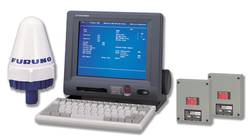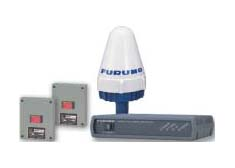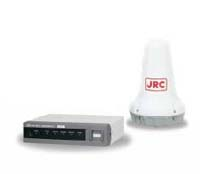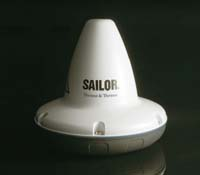The new SOLAS Chapter V Reg. 19-1 entered into force on 1 January 2008 introduced a requirement for Long-Range Identification and Tracking of Ships (LRIT) for certain categories of ships on international voyages, under a phased implementation programme as from 31 December 2008.
Ships required to transmit LRIT messages
Following ships when engaged on international voyages, are required to transmit LRIT messages:
- Passenger ships, including high speed craft
- Cargo ships, including high-speed craft, of 300 gross tonnage and upwards; and
- Mobile offshore drilling units.
Information to be transmitted.
The following information shall be transmitted automatically:
- Ship’s identity (Transmitting equipment identity)
- Ship’s position (GNSS position)
- Time and date of transmission (associated with the GNSS position.)

On-board equipment
LRIT data can be provided by using equipment already fitted on many ships, such as Inmarsat C, mini-C or D+. There will also be systems available which utilise alternative satellite networks and specifically designed to function within the LRIT infrastructure. All these systems have a built-in GNSS receiver, providing the vessel’s position, date and time. They also have the equipment-unique identification (ID) built in to them. Remote control of transmissions is also possible.
It is likely that the software of existing SMDSM equipment shall be up-dated for the purpose of LRIT operations.
Note: The SSAS system cannot be used for LRIT purposes.
On-board equipment requirements(IMO Resolution MSC.210(81))
The equipment must:
- be capable of automatically and without human intervention on board the ship transmitting the ship’s LRIT information at 6-hour intervals to an LRIT Data Centre;
- be capable of being configured remotely to transmit LRIT information at variable intervals;
- be capable of transmitting LRIT information following receipt of polling commands;
- interface directly to the ship-borne global navigation satellite system equipment, or have internal positioning capability;
- be supplied with energy from the main and emergency source of electrical power; and
- be compliant with EMC requirements by IEC 60945
Security of LRIT data
Information from LRIT transmissions will be restricted for use by Contracting IMO Member States and Administrations. It will not be available to third parties or other ships.
Timetable
The following implementation table gives the latest permitted implementation dates according to the areas in which ships operate.
| SHIPS (Over 300 gt) |
GMDSS AREA OF OPERATION (As defined in SOLAS Chapter IV) |
DATE OF LRIT IMPLEMENTATION |
| Ships constructed on or after 31 December 2008* | All |
From date of build |
| Ships constructed before 31 December 2008* |
A1 and A2, or A1, A2 and A3 |
Not later than 1st survey of the radio installation after 31 December 2008 |
| Ships constructed before 31 December 2008* |
A1, A2, A3 and A4** | Not later than 1st survey of the radio installation after 1 July 2009 |
* Ships, irrespective of date of build, operating ONLY in areas A1 and fitted with AIS are not required to transmit LRIT information.
** But when operating in areas A1, A2 and A3 they must comply with the earlier date of 31 December 2008.
Most existing Inmarsat C terminals are capable of providing the required LRIT information although a certain percentage will not be suitable unless updates are applied. It is possible that a specific configuration or minor installation problems can affect a terminal’s ability to transmit the LRIT signals, or even be updated to transmit the signal. So considering the high penalties for LRIT non-compliance, which could be tens of thousands of dollars per day in some cases, it is vital for vessel’s to start preparing for the 31st December 2008 LRIT deadline immediately.
Furuno Felcom 15

- Complies with IMO Res. A.807 (19) Inmarsat-C, A.664 (16) EGC Performance Standards, A.694 (17) General requirements, MSC.68 (68), MSC/Circ 862, MSC 55/25 Inmarsat, IEC 61097-4 Inmarsat-C/EGC
- Full coverage of Inmarsat-C services: EGC, Internet E-mail, distress message handling, polling, and data reporting
- General data exchange, telex, etc.
- GMDSS compliant with optional printer, AC/DC power supply unit
- Shipborne LAN connection by Ethernet 10Base-T
- 10.4″ COLOR LCD Display Unit for improved legibility of incoming and outgoing messages
- GPS position reporting
- Remote distress alert unit
- Two component system allows easy installation
- Optional software for Windows PC to run E-mail/Telex
- Optional internal GPS module
Equipment list:
- Antenna Unit IC-115 with 30 m Cable
- Terminal Unit IC-215 with Keyboard
- Junction Box IC-315
- Distress Alert/Received Call Unit IC-305
- Alarm Unit IC-306
- Installation Materials and Spare Part
Optional:
- GPS Board Kit OP16-24
- Printer PP-510
- Software for PC
- Antenna Cable 8D-FB-CV (50 m), 12D-FB-CV (100 m)
- AC/DC Power Supply Unit PR-240 (Required for EGC, IMO Res. A.664 (16)/4 to operate on ship’s mains)
- EGC Printer PP-505
Specification:
| Class identification: | Class 2 Inmarsat-C SES |
| Inmarsat-C services supported: | EGC receiving (SafetyNET™, FleetNET™) Distress message handling Two-way, digital store-and-forward message handling: Telex, FAX (PSTN), Internet E-mail, X.25 (PSDN), X.400 (MHS), Closed Network (DNID), Special Access Code Polling, Data Reporting |
| Frequency: Tx Rx |
1626.5 – 1646.5 MHz 1530.0 – 1545.0 MHz |
| Channel Interval: | 5 kHz |
| Modulation: | BPSK 600/1200 symbols/s |
| EIRP: |
7-16 dBW (at elevation angle 5°)
|
| Antenna Type: | Daisy Loop Antenna |
| Gain: Horizontal: Vertical: |
Omnidirectional 0 dBi or more (elevation 90°) +1.3 dBi or more (elevation 5°) |
| Axial Ratio: | Within 6 dB (5° to 90°) |
| VSWR: | 1.5 or less (50 ohm) |
| Display: | 10.4″ color LCD (207 × 160 mm) |
| Message: | 72 characters/line, 25 lines/screen |
| Serial interface device: | D-sub9, RS-232C |
| SSAS Alert Unit: | D-sub15 |
| Ethernet: | RJ-45, 10 Base-T |
| Navigational Equipment: | D-sub15, IEC 61162 |
| NMEA sentences: | BWC, BWR, DBT, GGA, GSV, GLL, MTW, RMA, RMB, RMC, WPL, VDR, VTG, ZDA |
| Dimensions: Terminal Unit IC-215 Antenna Unit IC-115 Junction Box IC-315 Distress Alert/Received Call Unit Alarm Unit IC-306 Printer PP-510 |
320 × 270 × 122 mm 258 ×Ø156 mm 160 × 120 × 40 mm 120 × 100 × 24 mm 120 × 100 × 24 mm 380 × 193 × 375 mm |
| Weight: Terminal Unit IC-215 Antenna Unit IC-115 Junction Box IC-315 Distress Alert/Received Call Unit Alarm Unit IC-306 Printer PP-510 |
4.5 kg 1.4 kg 0.7 kg 0.34 kg 0.33 kg 3.3 kg |
| Power supply: | 12-24 VDC, 140 W (TX), 60 W (RX) |
| Ambient Temperature: Antenna Unit Terminal Unit |
-35°C to +55°C -15°C to +55°C |
| Waterproof (IEC 60529) Antenna Unit Terminal Unit |
IPX6 IPX0 |
| Vibration: | according to IEC 60945 |
Furuno Felcom-16

- Employs Inmarsat C system
- Multi-addressed transmission enables in parallel reports to the flag administration as well as to company security officer
- Optional backup battery for continual operation up to 5 days
- GPS receiver incorporated
- Compact antenna and communication unit for ease of installation
- Polling function enables tracking of the ship, even after the ship loses communication due to attack by pirates
- Data reporting function enables reporting of ship’s position at regular intervals
- Diagnostic programs for maintenance
- Up to five appropriate stations can be registered to receive the SSAS report
Equipment list:
- Antenna Unit IC-116 with 15 m Cable
- Communication Unit IC-216
- 2 × SSAS Alert Unit IC-307
- Junction Box IC-315
- Software for PC
- Installation Materials and Spare Parts
Optional:
- AC/DC Power Supply Unit PR-240
- SSAS Alert Unit IC-307
- Printer
- Cable 15/50/100 m
Specification:
| Frequency: Tx Rx |
1626.5 – 1646.5 MHz 1530.0 – 1545.0 MHz |
| Channel Interval: | 5 kHz |
| Modulation: | BPSK 600/1200 symbols/s |
| Minimum G/T: | -23 dB/K (at elevation angle 5°) |
| EIRP: |
7-16 dBW (at elevation angle 5°)
|
| Antenna Type: | Daisy Loop Antenna |
| Gain: Horizontal: Vertical: |
Omnidirectional 0 dBi or more (elevation 90°) +1.3 dBi or more (elevation 5°) |
| Axial Ratio: | Within 6 dB (5° to 90°) |
| VSWR: | 1.5 or less (50 ohm) |
| Serial interface device: | D-sub9, RS-232C |
| SSAS Alert Unit: | D-sub15 (through the junction box) |
| Dimensions: | 340 × 270 × 104.2 mm |
| Weight: | 7 kg |
| Power supply: | 12-24 VDC, 60 W (TX), 10 W (RX) |
| Ambient Temperature: Antenna Unit Communication Unit |
-35°C to +55°C -15°C to +55°C |
| Waterproof (IEC 60529) Antenna Unit Communication Unit |
IPX6 IPX0 |
| Vibration: | according to IEC 60945 |
JRC JUE-95LT

- Compact antenna design
- Easy installation
- Built-in GPS receiver
- Low cost of ownership
- Fully meets IMO requirements for LRIT
The JUE-95LT is a simple-to-install stand alone system that will easily and accurately transmit key information to improve the safety of life at sea.
The JUE-95LT system has the same cable management philosophy resembling all other Inmarsat products that JRC is off ering, allowing for an easy installation as only a single coax cable is used between antenna and terminal. Both are very compact and can be easily installed on any size and type of vessel.
Scope of supply:
- Antenna unit NAF-742LT
- Terminal NTF-782LT
- Antenna & Terminal installation parts
- Antenna to terminal cable 30 m
- Power supply to terminal cable 2 m
- Spare parts
- Manual (English)
Options:
- Power supply (AC/DC) NBD-577C
- Earth bolt (for antenna) MTL318538A
Specification:
| Frequency range:
Rx: Tx:
|
1530.0 -1545.0MHz 1626.5 – 1646.5MHz |
| Channel spacing: | 5 kHz |
| G/T: | -23.7dB/K minimum at 5° angle |
| E.I.R.P.: | +7 to +16dBW |
| Modulation (TX and RX): | 1200 symbols/sec |
| Data rate: TX RX |
600bps 600bps |
| Antenna: | helical |
| Pattern: | hemisphere (non directional) |
| Polarisation: | right hand circular |
| Transmission message: | up to 8kb |
| Message storage: | 80kb (Inmarsat C 40kb) |
| Power supply: | DC 24V (+30% -20%) |
| Power consumption (terminal and antenna): TX RX |
75W 15W |
| Ambient condition: antenna terminal |
-35°C +55°C -15°C +55°C |
| Storage temperature: | -40°C +80°C |
| Relative humidity: | +40°C up to 95% |
| Icing: | up to 25mm (antenna) |
| Precipitation: | 100mm/hour (antenna) |
| Wind: | up to 100 knots |
| Vibration: | as specified by Inmarsat |
| Dimensions: Antenna unit Terminal |
224 × Ø144 mm
210 × 50 × 150 mm
|
| Weight:
Antenna unit
Terminal |
1.5 kg 1.3 kg |
Sailor TT-3000LRIT

The SAILOR TT-3000 LRIT is a stand-alone LRIT solution that fully meets the performance standard for LRIT as described in document MSC81/210 and is separated from other services such as GMDSS or SSAS. It is an easy-to-install fit-and-forget system, which does not even require a crew interface. The only requirement is power and as the entire package consists of just 3 parts, the mini-C transceiver, a pole mount and a connection cable (20/50m), it can be installed almost everywhere any time.
The SAILOR TT-3000LRIT is a cost-effective, fit-and-forget system comprising just three parts:
- Mini-C transceiver
- Connection Cable
- Pole Mount
Ease of installation is a key factor for standalone LRIT transceivers, and therefore the only thing needed to make the system operational, and make the vessel LRIT compliant is to connect the transceiver to power via the standard mini-C cable. With such simple installation, it is possible to save money further through self-installing by ship’s engineers.
Specification:
| Antenna: | Inmarsat-C/GPS omni-directional |
| Elevation angle: | -15° to 90° |
| Operating frequencies:
Rx Tx
GPS: |
1525.0 – 1559.0MHz
1626.5 – 1660.5MHz
1575.42 MHz |
| GPS module: | 12-Channels |
| Update rate: | 1 sec |
| Accuracy: | 15m |
| Solar radiation: | 1200W/m2 |
| Precipitation: | Up to 100 mm/hour |
| Droplet size: | 0.5 to to 4.5mm at wind speed up to 200km/h |
| Ice: | Up to 25 mm |
| IP rating: | Lloyds approved for IP66 Tested for IP68 by Thrane & Thrane |
| Temperature range:
Operating Storage
|
-35°C to 55°C
-40°C to 80°C
|
| Power supply: Operating: DC Nominal: |
10.5V – 32V, floating 12V – 24V (at max. 20m cable) |
| Power consumption:
Rx Tx
|
1.8W (stand by)
23W (at 12V DC supply)
|
| Dimensions: | Ø163 × 146 mm |
| Weight: | 1.1 kg |